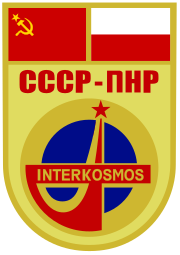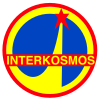cosmos.wikisort.org - Spacecraft
Soyuz 30 (Russian: Союз 30, Union 30) was a 1978 crewed Soviet space flight to the Salyut 6 space station. It was the sixth mission to and fifth successful docking at the orbiting facility.[2] The Soyuz 30 crew were the first to visit the long-duration Soyuz 29 resident crew.
The Soyuz 30 capsule, Hermaszewski's spacesuits and personal items, as well as memorabilia from the flight on display. | |
| COSPAR ID | 1978-065A |
|---|---|
| SATCAT no. | 10968 |
| Mission duration | 7 days, 22 hours, 2 minutes, 59 seconds |
| Orbits completed | 125 |
| Spacecraft properties | |
| Spacecraft type | Soyuz 7K-T/A9 |
| Manufacturer | NPO Energia |
| Launch mass | 6,800 kilograms (15,000 lb) |
| Crew | |
| Crew size | 2 |
| Members | Pyotr Klimuk Mirosław Hermaszewski |
| Callsign | Кавказ (Kavkaz - "Caucasus") |
| Start of mission | |
| Launch date | 27 June 1978, 15:27:21 UTC |
| Rocket | Soyuz-U |
| Launch site | Baikonur 1/5[1] |
| End of mission | |
| Landing date | 5 July 1978, 13:30:20 UTC |
| Landing site | 300 kilometres (190 mi) W of Tselinograd |
| Orbital parameters | |
| Reference system | Geocentric |
| Regime | Low Earth |
| Perigee altitude | 197.6 kilometres (122.8 mi) |
| Apogee altitude | 261.3 kilometres (162.4 mi) |
| Inclination | 51.66 degrees |
| Period | 88.83 minutes |
| Docking with Salyut 6 | |

Soyuz programme (Crewed missions) | |
Soyuz 30 carried Pyotr Klimuk and Mirosław Hermaszewski, the first (and to date, only) Polish cosmonaut, aloft.
Crew
| Position | Cosmonaut | |
|---|---|---|
| Commander | EP-3 Third and last spaceflight | |
| Research Cosmonaut | EP-3 Only spaceflight | |
Backup crew
| Position | Cosmonaut | |
|---|---|---|
| Commander | ||
| Flight Engineer | ||
Mission parameters
- Mass: 6,800 kg (15,000 lb)
- Perigee: 197.6 km (122.8 mi)
- Apogee: 261.3 km (162.4 mi)
- Inclination: 51.66°
- Period: 88.83 minutes
Mission highlights

The second Intercosmos mission was launched 27 June 1978 to the orbiting Salyut 6 space station. The Soyuz docked with the space station on 29 June, and cosmonauts Klimuk and Hermaszewski were greeted by Vladimir Kovalyonok and Aleksandr Ivanchenkov, the resident crew who had been on board for 12 days. For the third time, the Salyut was a four-man orbiting space laboratory.[3]
The activities of the Soyuz 30 crew, however, were severely curtailed so as not to interfere with the Soyuz 29 crew. On the Soyuz 29 crew's rest day, the international crew had to stay in their Soyuz to perform their experiments.[4] Nevertheless, Hermaszewski conducted many experiments. One was crystallization experiments which produced 47 grams of cadmium tellurium mercury semiconductors for use by infra-red detectors on board the station. The yield was far greater - 50% compared to 15% - than ground-based experiments.[4]
The Soyuz 30 crew was trained, as all international crews, in the use of the MKF-6M camera. Training in part took place on a Tu-134 flying at 10 km to best mimic conditions on the station.[4] Hermaszewski photographed Poland in co-ordination with aircraft taking close-up photos, but bad weather over Poland limited the photo sessions.[4] They additionally filmed the Aurora Borealis.[3]
Hermaszewski participated in medical experiments which measured lung capacity and the heart during exercise and in a pressure suit. One experiment, which all four on board the station participated in, was Smak (the Polish word for taste), a taste experiment which sought answers to why some food was less palatable in weightlessness.[4]
The Soyuz 30 crew packed their experiments into their capsule and returned to Earth 5 July, landing in a Rostov state farm field 300 km west of Tselinograd.[4]
See also
- List of human spaceflights to Salyut space stations
- List of Salyut expeditions
References
- "Baikonur LC1". Encyclopedia Astronautica. Archived from the original on 2009-04-15. Retrieved 2009-03-04.
- The mission report is available here: http://www.spacefacts.de/mission/english/soyuz-30.htm
- Clark, Phillip (1988). The Soviet Manned Space Program. New York: Orion Books, a division of Crown Publishers, Inc. ISBN 0-517-56954-X.
- Newkirk, Dennis (1990). Almanac of Soviet Manned Space Flight. Houston, Texas: Gulf Publishing Company. ISBN 0-87201-848-2.
На других языках
- [en] Soyuz 30
[es] Soyuz 30
Soyuz 30 fue una misión de una nave Soyuz 7K-T lanzada el 27 de junio de 1978 desde el cosmódromo de Baikonur con dos cosmonautas a bordo hacia la estación espacial Salyut 6. En ella viajaba el segundo cosmonauta no soviético en el marco del programa Intercosmos.[ru] Союз-30
«Союз-30» — пилотируемый космический полет транспортного пилотируемого космического корабля Союз на орбитальную станцию Салют 6. Это был второй космический полет организованный в рамках международной программы космических Интеркосмос и первый с участием польского космонавта.Другой контент может иметь иную лицензию. Перед использованием материалов сайта WikiSort.org внимательно изучите правила лицензирования конкретных элементов наполнения сайта.
WikiSort.org - проект по пересортировке и дополнению контента Википедии






